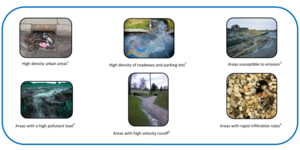
Pre-treatment considerations for stormwater infiltration
Infiltration BMPs are susceptible to clogging from the trash, debris, and suspended sediments present in runoff. Pretreatment can remove debris and coarser sediments in an easier-to-maintain pre-treatment device that will extend the life and reduce maintenance for the infiltration BMP. If work is being done under an MPCA Permit, then it is REQUIRED that some form of pre-treatment be installed upstream of an infiltration BMP. In all other cases pretreatment is highly recommended.
Situations where pre-treatment is particularly important

Pretreatment is of particular importance in the following situation
- High density urban areas. High density urban areas are more likely to contain high concentrations of trash, sediments, and pollutants which can be carried by the stormwater runoff. High density urban areas contain a higher concentration of roadways; of particular concern with roadways are trash, debris and sediments (making pre-treatment an important part of the BMP) as well as metals and chlorides.
- Areas with high potential for erosion. Areas that are susceptible to erosion are of concern because of high sediment loads that reduce the BMP’s infiltration capacity. This will clog the infiltration BMP.
- Areas where stormwater has a high pollutant load. Areas with a high pollutant load, or the presence of certain pollutants that are not easily removed from runoff are a concern because they have the potential to contaminate the groundwater.
- Storm sewers that convey runoff at a high velocity. A high velocity will keep sediment in suspension. Pretreatment should be installed to facilitate the proper settling of the sediment, which will prevent clogging. In addition, high velocities can reduce the volume of runoff that can be infiltrated.
Common pre-treatment methods
Forebays (small sediment basins) are the most common pretreatment method, though there are many others, including cisterns, drain inlet inserts, green roofs, oil/water separators, proprietary settling/swirl chambers, vegetated filter strips, and vegetated swales. It is important to note that many of these pretreatment techniques will require routine maintenance.
- Forebays. Forebays, also known as plunge pools, are small basins upstream of other BMPs that dissipate the velocity of the incoming water and provide stilling, sedimentation, and trapping of gross pollutants.
- Cisterns. Cisterns are tanks located above or below ground that are used for storing a specific amount of runoff for the purpose of non-potable reuse (e.g. irrigation or vehicle washing). Small cisterns are also known as rain barrels. These completely remove the runoff from the treatment train and, therefore, provide 100 percent pollution reduction from the volume of water retained. Cisterns are often used to collect stormwater runoff from rooftops (termed rainwater harvesting), but they can also be used to intercept runoff from other impervious areas.
- Drain Inlet Inserts. Drain inlet inserts are devices placed into stormwater drains or catch basins to remove pollutants from stormwater prior to entering the storm sewer system. These inserts utilize an inert filter material, such as polypropylene, to enhance pollutant removal (WEF, 2012). Drain inlet inserts have the ability to remove debris, trash, large sediments and, if a filter material is present, can also remove oils/greases and other pollutant types.
- Green roofs. Green roofs capture rainfall on a roof top vegetated surface before the rainfall is allowed to become runoff. These are located at the beginning of the stormwater treatment train to provide volume reduction and to prevent runoff from collecting pollutants associated with rooftops. As green roofs employ a media for the vegetation, they are often times not effective at removing phosphorous and do not get credit for phosphorous removal in this Manual.
- Oil/water separators. Oil/water separators are structures designed specifically to remove petroleum hydrocarbons, grease, sand, and grit. These separators can be split into two categories, American Petroleum Institute (API) separators and coalescing plate separators (WEF, 2012). API separators are a larger vault with baffles which enhance hydraulic efficiency. Coalescing plate separators use sloped plates or extruded tubes to achieve sediment and oil removal, and are smaller than the API structures.
- Proprietary settling/swirl chambers. Proprietary settling/swirl chambers or concentrators, also known as hydrodynamic devices, cause the stormwater to move in a circular motion which enhances the settling out of sediments. These devices often remove solids, oils/grease, floatable sand, and other larger debris from stormwater runoff.
- Vegetated filter strips. Vegetative filter strips reduce the velocity of stormwater runoff, allowing the sediments to settle out. Filter strips work best when receiving runoff as sheet flow, making them suitable alongside roads, parking lots, and other paved surfaces.
- Vegetated swale. Vegetated swales are similar to vegetated filter strips. These devices are better suited for concentrated flow in addition to sheet flow of runoff. The flow path through the swale allows for the settling and filtration of coarse particles, and limited infiltration.